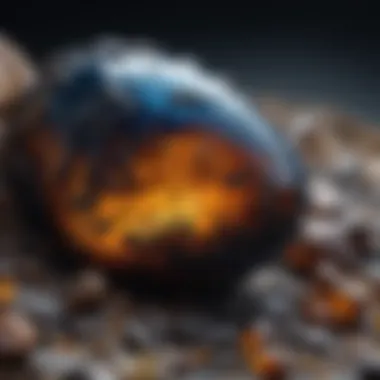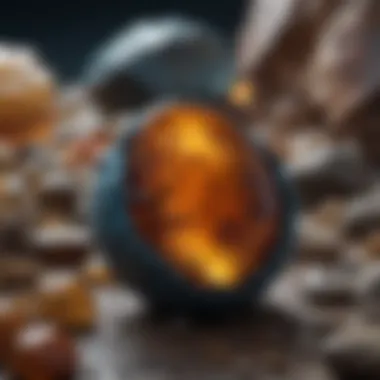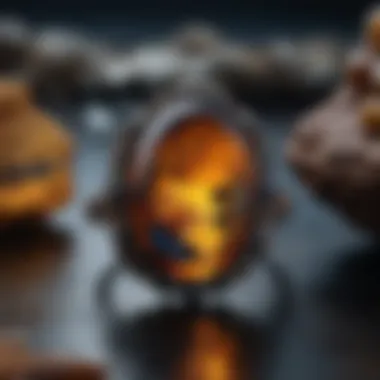Exploring the Allure of Baltic Blue Amber


Intro
Baltic blue amber, often dubbed as a true natural marvel, finds its roots in the ancient forests of the Baltic region. This organic gemstone is not only cherished for its striking hues but also for its rich tapestry of history and geological significance. In this exploration, we’ll uncover the myriad facets that make Baltic blue amber a coveted treasure among collectors and enthusiasts.
As we delve into its history and origins, we will map its journey from ancient geological formations to contemporary uses in jewelry and art. We will also shed light on the methods of identifying and classifying this unique resin, which entices many with its allure.
History and Origins
Overview of Collectibles, Rocks, and Fossils
To understand Baltic blue amber, one must first appreciate the broader context of collectibles such as rocks and fossils. Collecting has long been a pastime that connects people to the Earth's narrative. Fossils encapsulate ancient life, while gemstones like amber provide a link to geological processes that span millions of years.
The allure of Baltic blue amber is particularly pronounced in this realm. It emerges from specific coniferous trees that thrived in prehistoric times. When these trees succumbed to environmental changes, the tree resin developed into amber, preserving artifacts of a bygone era, including insects and plant matter trapped within.
Historical Significance and Cultural Impact
Throughout history, amber has been more than just a pretty stone. It has played significant roles in various cultures. In ancient societies, Baltic amber was used as currency and adorned in rituals due to its perceived protective and healing properties. Roman artifacts, for instance, show the value placed on amber during trade, often emphasizing how it crossed continents.
The cultural tapestry surrounding Baltic amber is woven with tales of myth and legend. From tales of gods and spirits to its mention in medical texts, this gemstone has navigated through time, enriching itself within cultural contexts. Collectors often seek it not just for its beauty but for the stories embedded in its very essence.
"Amber is the gold of the ancient forest, holding millennia in its clarity."
Identification and Classification
Guide to Identifying Rocks and Fossils
For the discerning collector, recognizing true Baltic blue amber is paramount. True amber can be differentiated by key characteristics including:
- Color: The blue hues of Baltic amber range from vibrant cerulean to deeper oceanic shades, often eliciting comparisons to the sea.
- Weight: Amber is lightweight compared to many gemstones. A good quality piece should feel almost buoyant.
- Translucence: Quality amber displays a clear, glass-like quality, allowing you to behold the intriguing internal contents.
- Inclusions: Many pieces contain fascinating inclusions such as insects or botanical fragments, offering a tiny window into the past.
Common Types and Variations
Amber comes in various types, with Baltic blue amber being one of the rarest varieties. Other notable mentions include:
- Cognac Amber: Known for its deep, warm hues, often rich in organic inclusions.
- Green Amber: A unique find that creates a captivating visual effect.
- Honey Amber: Probably the most recognisable, this type has a rich, warm tone popular in both jewelry and crafts.
In essence, every piece of Baltic blue amber tells a story. For collectors, cultivating an understanding of its identification not only enhances the quality of their collection but also fosters a deeper appreciation for this organic gem's journey through time.
Preface to Baltic Blue Amber
In the realm of natural gemstones, Baltic blue amber stands out as a remarkable artifact that has piqued the interest of both collectors and enthusiasts. Its bluish hue, reminiscent of the calm sea on a sunny day, sets it apart from the more commonly known shades of amber. This section aims to clarify what makes Baltic blue amber unique and significant within this multifaceted field, emphasizing both its natural origins and its captivating beauty.
Understanding Baltic blue amber not only enriches one’s knowledge of geological processes and time but also highlights the intricate relationship between nature and human culture. Collectors who are informed about these unique aspects can better appreciate the subtleties of Baltic amber and its role in both history and modern craftsmanship.
The exploration of Baltic blue amber begins with a deep understanding of its characteristics, historical journey, and cultural significance, all of which contribute to its valuation in today’s market.
What is Baltic Blue Amber?
Baltic blue amber, a type of fossilized tree resin, is primarily found along the Baltic Sea's coast. This natural gem has earned a reputable place in jewelry and art due to its striking color and intriguing qualities. Unlike traditional amber, which typically exhibits yellow or brown hues, Baltic blue amber protrudes an array of blue shades ranging from pale to deep tones, sometimes accompanied by hints of green.
This coloration is a result of various factors, including geological formations and the chemical processes that take place over millions of years. Baltic blue amber is not just a pretty stone; it sometimes contains inclusions – trapped bubbles of gas, tiny insects, or plant matter – that further add to its mystique and value. Such characteristics make it a coveted item among collectors and jewelers alike.
A Brief History of Amber
The history of amber is as complex as its formation. Primarily originating from fossilized resin of ancient trees in the northern regions, amber has been known for thousands of years. The earliest evidence suggests that humans have engaged with amber since the Neolithic period. Archaeological finds display amber being used in the creation of jewelry, burial items, and even trade goods.
Throughout the ages, different cultures revered amber for various reasons:
- In ancient Rome and Greece, amber was believed to have protective properties. It was often worn as amulets or used in making various artifacts.
- In Norse mythology, it symbolized warmth and light during the harsh winters.
- During the Renaissance, it became a highly sought-after commodity, with European nobility using amber in elaborate pieces of art and jewelry.
Before long, Baltic amber became synonymous with craftsmanship, leading to a thriving trade network spanning Europe and Asia. Its timeless appeal continues to captivate collectors today, linking the past with the present in the most elegant way.
Formation and Characteristics


Understanding the formation and characteristics of Baltic blue amber is crucial in grasping the essence of this extraordinary organic gemstone. Often seen as a mere decoration, there’s a profound story behind its creation and unique features that elevate it to a symbol of natural artistry. This section emphasizes the geological processes and distinctive attributes that make Baltic blue amber a sought-after item among collectors today.
The Geology Behind Amber
Amber itself is fossilized tree resin, primarily from coniferous trees, dating back millions of years. The Baltic region, particularly around the shores of the Baltic Sea, is renowned for its deposits. This amber originated during the Late Eocene to the Early Oligocene epochs, where resin left trees in the ancient forests underwent a transformation into solid, earth-imbued jewels over time. The geological conditions—such as temperature and pressure—play a significant role in influencing the amber's qualities.
The process of its formation can be likened to a slow cooking of vegetables in a stew, where factors like heat and time bring together diverse elements into a single, flavorful outcome. Likewise, Baltic blue amber showcases some of the most beautiful shades of blue—an indicator of specific conditions during its formation. This unique formation story adds to the object's charm, enhancing its desirability for both collectors and enthusiasts.
Unique Properties of Baltic Blue Amber
Baltic blue amber stands out not just for its origins but also for its unique characteristics, which can set it apart from other types of amber. Understanding these properties can aid collectors in identifying genuine pieces and appreciating them fully.
Color Variations
One of the most appealing aspects of Baltic blue amber is its color spectrum, ranging from rich honey hues to vibrant blues. The blue color specifically derives from light interactions within the amber. It's not merely a pigment; the wavelength reflections cause this mesmerizing blue that many cherish.
The key characteristic of these colors contributes significantly to the overall appeal, with blue amber being especially valued for its rarity. Many buyers find themselves drawn to the depths of color that remind them of the ocean depths or the vast sky. However, potential collectors should be cautious. Color variations may sometimes indicate treatments or impurities, prompting the need for careful evaluation.
- Advantages: Unique aesthetic value, rarity in the collection world.
- Disadvantages: Misleading representations can lead buyers astray.
Transparency
Transparency plays a vital role in defining the allure of Baltic blue amber. The degree to which light passes through can reveal much about the piece’s quality. Collectors often seek pieces that possess a clear transparency that showcases the play of light and shadows within.
The key characteristic here is the clarity, which can also reflect on the gemstone’s value. Gem-quality amber, especially blue, can exhibit a spectacular glow when light strikes it just right. This transparency can highlight inclusions—a natural aspect that many collectors find intriguing.
- Advantages: Enhances visual appeal and value.
- Disadvantages: Cloudy or opaque pieces may be less desirable.
Inclusions
Inclusions in amber tell a story of ancient life; they are the tiny fragments of plants, insects, or other organisms trapped in the resin. These inclusions contribute to the unique character of each piece. Baltic blue amber, with its sometimes rare inclusions, holds a distinctive charm that attracts historians and collectors alike.
The key characteristic of inclusions is their ability to give each amber piece a narrative. People often find themselves captivated by the thought of ancient insects that were preserved in time, creating a conversation starter about nature and history.
- Advantages: Adds historical value and uniqueness.
- Disadvantages: Can decrease value if they are obscured or damaged.
Overall, the formation and characteristics of Baltic blue amber encapsulate the intricate relationship between nature and time, conveying not only beauty but also the narrative of the Earth. Each piece carries a history waiting to be uncovered, striking a chord with collectors and nature enthusiasts alike.
Identifying Baltic Blue Amber
Identifying Baltic blue amber is crucial for anyone deeply involved in the world of natural gems. Given its unique characteristics and historical significance, recognizing authentic pieces can make or break a collector's journey. This section offers insights into vital identification methods that not only enhance the collector's experience but also protect against potential fakes. Whether you're a seasoned collector or new to the game, understanding these techniques provides a foundation for appreciation.
Visual Identification Techniques
When it comes to spotting real Baltic blue amber, visual cues are your first line of defense. Here are some key aspects to look for:
- Color: Authentic Baltic blue amber exhibits a range of colors, including soft pastel blues, greens, and even hints of more vibrant hues. However, a consistent deep hue is often a sign of quality. If the item is unnaturally bright or fluorescent, you might be looking at a synthetic alternative.
- Clarity: Natural amber possesses a degree of transparency. Examine the piece for cloudiness or bubbles inside, indicative of a counterfeit resin. Real amber can contain inclusions like tiny insects or plant bits, which add to its charm.
- Surface Texture: The surface of real Baltic blue amber is typically smooth yet can have tiny imperfections. If you see a flawless surface, it could be a red flag. Authentic amber often has a somewhat waxy texture, differing from the glass-like finish of imitations.
It's worth noting that using a magnifying glass can enhance your examination. Get close and personal! Sometimes, the smallest details tell the world you found the genuine article.
"The beauty of Baltic blue amber is not just its color but the stories it holds within. Every inclusion, every air bubble sings a song of the past."
Chemical Tests for Authenticity
When visual techniques aren't enough to assure authenticity, chemical tests come into play. Here are some methods you might consider:
- Solubility Test: Real amber is not soluble in alcohol or water. If a drop of alcohol causes cloudiness or a change in the piece, beware!
- Density Test: Authentic Baltic amber has a specific gravity of approximately 1.05. You can perform a simple water test; real amber floats while most synthetics sink. Use a calibrated scale if precision matters to you.
- Infrared Spectroscopy: For those willing to spend a bit more, infrared spectroscopy is a reliable method. This high-tech approach can reveal a lot about the chemical structure of your amber, offering sounds evidence of its origin.
Both visual cues and chemical tests contribute significantly to identifying Baltic blue amber. As you continue your journey into this treasured realm, arming yourself with these skills ensures that you appreciate nature's gem to its fullest.
Understanding how to identify this unique resin not only elevates your collection but also deepens your appreciation for its distinct history and inherent beauty.
Cultural Significance
The cultural significance of Baltic blue amber is profound and multi-faceted. For centuries, this captivating gem has woven its way into the fabric of various societies, becoming a symbol of creativity, heritage, and natural beauty. Blue amber stands apart from its more commonly seen cousins, often evoking a deep sense of mystery and admiration among collectors and enthusiasts alike. Understanding the cultural implications of this unique gemstone offers insight into human history and the relationship between nature and art.


Baltic Traditions Involving Amber
In the Baltic region, amber has held a place of reverence, dating back thousands of years. Ancient peoples believed that amber held protective properties. It was thought to ward off evil spirits, a belief that resulted in the inclusion of amber amulets in various rituals and practices. Such traditions have not only persisted but have also evolved, capturing the imaginations of contemporary artisans. As a part of folk medicine, it was ground into powder for various remedies—a practice that continues in specific cultures today.
- Rowan Tree Charm: One popular tradition involved threading amber beads onto a rowan tree branch. This was believed to enhance the branch’s protective qualities against malevolent forces.
- Wedding Rites: In certain Baltic cultures, amber is integral to wedding ceremonies. Brides often wear amber jewelry as a symbol of love and prosperity.
- Healer’s Stone: Some cultures sought out amber for its purported ability to promote healing. It was believed that the stone could harmonize energies and foster vitality.
These customs illuminate the extensive role that amber has played in shaping Baltic identity. As generations have passed, the genuine connection between the people and this organic gemstone remains palpable.
Amber in Art and Jewelry
The applications of Baltic blue amber in art and jewelry are a testament to its enduring allure and versatility. Craftsmen have been creating intricate pieces that showcase amber for centuries. The vibrant hues and unique inclusions in each piece open avenues for endless creativity.
In jewelry making, artisans have harnessed the beauty of blue amber to produce stunning necklaces, bracelets, and earrings. Each piece tells a story, often encapsulating natural motifs or cultural symbols. Notably, many artists pride themselves on traditional techniques that have been handed down through generations.
Additionally, amber finds its way into more than just adornments:
- Sculptures: Some artists create bold and imaginative sculptures from amber, using it to represent both the natural world and human emotions.
- Decorative Objects: You can find amber in various home decor items—ranging from candle holders to picture frames, showcasing its aesthetic appeal and charm.
- Fused with Other Elements: Some contemporary artists blend amber with metals or glass, pushing the boundaries of conventional amber craftsmanship.
With its rich palette of color and historical importance, Baltic blue amber continues to inspire modern artists, making it a cherished material in the art world.
"Amber is the tapestry of time; it encapsulates our stories, ignites our imagination, and remains a bonding thread across cultures and centuries."
As we dive deeper into the myriad uses and manifestations of amber, it becomes clear that its cultural significance is not merely in its beauty. Baltic blue amber is a link to our past, an echo of civilization's journey with nature.
Uses of Baltic Blue Amber
Baltic blue amber, a stunning and rare variant of amber, has captured the attention of both collectors and artisans throughout history. Its unique properties lend itself not only to aesthetic appreciation but also to various practical applications. From traditional uses in ancient cultures to contemporary roles in design and medicine, the utility of Baltic blue amber has evolved remarkably, making it an essential topic in understanding both its value and significance.
This section explores the historical uses across different cultures and sheds light on current applications in diverse fields, presenting a well-rounded picture of how this exquisite material is utilized.
Historical Uses Across Cultures
Throughout the ages, Baltic blue amber has held a special place in many societies. Its captivating color and intriguing inclusions made it not only visually appealing but also rich in symbolic meanings.
- Ancient Traditions: Many early civilizations regarded amber as a protective stone, believing it held the ability to ward off evil spirits. It was often used in amulets or carved figurines, serving as a guardian for the wearer. For instance, in ancient Rome and Greece, people made jewelry and other decorative items from amber, showcasing their craftsmanship while also adhering to cultural beliefs tying the gem to wellness and spirituality.
- Medicinal Properties: Baltic blue amber was also utilized for its perceived health benefits. During the Middle Ages, it was common to find it in medicinal recipes. Doctors would often grind amber into powder and apply it for various ailments, from respiratory issues to joint pain. This tradition lingers, with some modern holistic practices still advocating for amber’s therapeutic effects.
- Trade and Economy: The trade routes of the Amber Road facilitated the exchange of amber across Europe, especially in the Baltic region. In the past, pieces of blue amber were valuable commodities, often compared to currency. It spurred economic activity and even influenced cultural exchanges between diverse communities.
The historical significance of Baltic blue amber not only enriches our understanding of past civilizations but also emphasizes its lasting impact on trade, culture, and medicinal practices.
Current Applications in Design and Medicine
As we have moved into modern times, the applications of Baltic blue amber have diversified substantially. Different industries have found ways to incorporate this natural resin into their products, keeping the spirit of tradition alive while innovating for new possibilities.
- Artisanal Jewelry: Presently, designers craft exquisite jewelry pieces featuring Baltic blue amber. The stone’s vibrant hues and rare inclusions make it a favorite in crafting necklaces, bracelets, and earrings. Artisans often combine it with metals like silver or gold, creating striking contrasts that amplify its beauty.
- Interior Design: Amber has made its way into home décor as well. Some designers utilize blue amber in furniture design, light fixtures, and decorative items, marrying the old with the new. It not only adds a touch of elegance but also serves as a conversation starter for guests with an interest in natural history.
- Holistic Healing and Wellness Products: Today, many people seek out Baltic blue amber for its rumored health benefits. Products like teething necklaces for infants are quite popular among parents. The gentle warmth of amber is thought to soothe teeth pain and calm fussy babies, bridging ancient practices with contemporary parenting.
- Scientific Research: Interestingly, Baltic amber is also of immense interest to scientists. Its ability to preserve inclusions helps researchers study historical environments and ecosystems. Fossils and trapped organic matter within the amber shed light on ancient life forms, making it a valuable tool in paleontology.
"The multifaceted uses of Baltic blue amber reflect its allure and enduring relevance in various domains, from art to health sciences."
Valuation and Market Trends
The valuation of Baltic blue amber is not merely about assigning a price tag; it reflects a blend of cultural heritage, artistic craftsmanship, and environmental factors. Since the appeal of this unique gemstone extends beyond mere aesthetics, understanding its market trends helps both collectors and enthusiasts gauge the significance of their acquisitions. The interplay of supply and demand, coupled with global market dynamics, makes this aspect crucial for anyone invested in the amber sphere.
Factors Influencing Amber Prices
The various elements that dictate the price of Baltic blue amber are as diverse as the hues within the stones themselves. Here are some critical factors in determining how much a piece can be worth:
- Rarity: Blue amber, known for its distinctive hue, is less common than traditional amber varieties. Its limited availability, especially in larger sizes or flawless specimens, drives higher prices.
- Quality and Inclusions: The presence of natural inclusions, such as insects or plant matter, often elevates a piece's value. However, inclusions should be appealing, as overly damaged specimens can detract from worth.
- Market Demand: The surge in interest from collectors around the globe, particularly in Asia and North America, has increased demand. Trends shift, and currently, an uptick in awareness about natural and holistic healing properties propels the value further.
- Authenticity: The ability to prove that a piece is indeed Baltic blue amber rather than a synthetic or imitated version is essential in the valuation process. Authentic pieces fetch far better prices.
The spectrum of values can vary significantly, and while some enthusiasts might stumble upon a gem for a few dollars, others may cough up thousands at auctions or specialty stores.
Understanding the Amber Market
Navigating the amber market requires more than just a keen eye for aesthetics; it demands understanding its complexities and historical context. The market is influenced by a variety of historical and cultural factors:
- Cultural Trends: The way amber is perceived changes over time. In some cultures, it is regarded as a symbol of protection and health, compelling the worth higher.
- Geopolitical Factors: Political climate impacts trade routes and thus the availability of amber. The Baltic region’s historical and ongoing conflicts can alter shipping capabilities which affect global supply.
- Artisan Trends: Craftsmanship trends also play a crucial role. Item designs, especially in jewelry, can lead to fads that temporarily inflate prices. Vintage styles also bring back previous interests.
- Online Trading Platforms: Online markets such as eBay, Etsy, and specialized forums like Reddit have changed how amber is bought and sold, broadening exposure for both buyers and sellers.


Understanding these trends will not only aid in making informed decisions but also enhance appreciation for the value that Baltic blue amber represents in various facets of life.
Caring for Baltic Blue Amber
Caring for Baltic blue amber is vital for preserving its beauty and ensuring the longevity of this exquisite material. As a collector or enthusiast, understanding the best practices for maintenance can greatly enhance your enjoyment of these unique pieces. Not only does proper care keep your amber looking its best, but it can also increase its value and historical significance within your collection.
Cleaning and Maintenance Practices
When it comes to cleaning Baltic blue amber, it's essential to tread lightly. Given its somewhat fragile nature, rough methods or harsh chemicals can do more harm than good. Here are some effective practices to keep in mind:
- Gentle Cleaning: Use a soft, lint-free cloth to wipe away dust and particles. A mild soap solution, made from a couple of drops of liquid dish soap mixed with warm water, can be used for more stubborn dirt. Always make sure to rinse thoroughly and dry with a soft cloth afterward.
- Avoid Excessive Heat: Amber is sensitive to high temperatures, so never run hot water over your pieces or leave them in direct sunlight for prolonged periods. Heat can cause the amber to lose its luster or even break down.
- Steer Clear of Chemicals: Avoid using abrasive cleaners, alcohol, or ammonia-based solutions, as these can damage the surface of the amber. Stick to natural, gentle options to preserve the integrity of your gems.
"Taking care of Baltic blue amber is not just about keeping it clean; it's about respecting a piece of ancient history that has traveled through time."
Regular maintenance, such as visually inspecting your pieces for scratches or cracks, can let you catch any issues before they grow. A little vigilance goes a long way when it comes to safeguarding your treasures.
Storage Recommendations
Proper storage of Baltic blue amber is equally as crucial as cleaning. The wrong storage can lead to scratches or damage that could otherwise be avoided. Consider the following tips for safeguarding your collection:
- Use Soft Storage: Keeping amber pieces in soft pouches or lined jewelry boxes can help prevent scratching. Wooden or velvet-lined boxes offer gentle cushioning without scratching the surface.
- Keep Away from Direct Sunlight: Prolonged exposure to sunlight can lead to discoloration. Store your amber in a dark, cool place away from windows to protect it from ultraviolet light.
- Avoid Jumbled Arrangements: Rather than tossing multiple pieces into a single container, give each piece its own space. This prevents rubbing against one another, which can wear down their surfaces over time.
- Humidity Control: An overly dry environment can make amber brittle. Use a humidity control pack in your storage area if necessary to maintain a suitable moisture level.
- Temperature Moderation: Aim for a stable temperature. Avoid extreme fluctuations, as this can stress the amber and lead to cracks.
In summary, caring for Baltic blue amber involves a blend of careful cleaning and thoughtful storage practices. By taking these steps, you not only enhance the visual appeal of your collection but also contribute to the preservation of a remarkable natural artifact.
Environmental Impact and Ethical Considerations
The allure of Baltic blue amber goes beyond its natural beauty and mystical attributes. Understanding the environmental impact and ethical considerations surrounding its sourcing reveals the complexity of this gemstone’s journey from nature to the collector's hands. As individuals become increasingly aware of sustainability and ethical sourcing in the luxury market, these topics take on heightened relevance.
Sustainability in Amber Sourcing
Sustainability is at the heart of any responsible collecting ethos. Baltic blue amber, primarily sourced from the rich landscapes of the Baltic region, raises significant questions about how the extraction processes affect the surrounding environment. While amber mining is often seen as a lesser invasive activity compared to more intensive forms of mining—like those for diamonds or gold—it still poses potential risks to local ecosystems.
Miners have to balance the demand for this sought-after gemstone with the duty to protect the natural habitats where these resources are found. Efforts are being made to employ more sustainable mining techniques. Practices such as selective harvesting, where only a certain amount of amber is collected based on specific criteria, help ensure that the ecological balance is preserved.
Moreover, partnerships between miners and environmental organizations are becoming more common. These initiatives aim to restore areas affected by mining and promote conservation efforts, contributing positively to the local community. As a collector, choosing to support sources that prioritize sustainability fosters a cycle of responsible consumption.
Ethical Quandaries in the Market
Alongside sustainability lies the tricky realm of ethics in the amber market. The demand for Baltic blue amber has surged, stirring up issues related to forced labor, exploitation of workers, and the legality of sourcing methods in certain regions. Not all amber that reaches the market comes from responsible sources.
The following points encapsulate the most pressing ethical concerns:
- Transparency: Information about where and how amber is sourced isn't always clear. Some suppliers may knowingly or unknowingly engage in practices that harm communities and environments.
- Worker Rights: Miners, in many cases, work in harsh conditions for minimal pay without adequate protection or rights.
- Illicit Trade: The illegal collection of amber can lead to biodiversity loss, affecting not just the immediate area but entire ecosystems.
Collectors and enthusiasts are encouraged to educate themselves and seek out ethical sources. Supporting businesses that adhere to fair trade practices can drive change by holding others accountable. It’s about finding the balance between a passion for collecting and aligning with values that prioritize human rights and environmental integrity.
"In the intricate web of nature and commerce, each piece of amber tells a story of our choices—both good and bad."
Navigating the world of Baltic blue amber is not merely about ownership; it’s about making informed choices that contribute to a sustainable and ethical future for this cherished natural treasure.
Closure
The significance of Baltic blue amber, as discussed throughout this article, cannot be overstated. For collectors, this organic gemstone offers not just aesthetic beauty but a rich narrative rooted in history and nature. Understanding its unique properties, value in the market, and the cultural implications adds layers of appreciation to this treasured material.
The Future of Baltic Blue Amber in Modern Collecting
As we look ahead, the interest in Baltic blue amber only seems poised to grow. Collectors today prioritize authenticity, sustainability, and ethical sourcing. These factors could notably influence the market and its dynamics. The rise of eco-conscious consumers highlights the necessity for transparency in sourcing, compelling sellers to adhere to ethical practices. Moreover, as environmental awareness permeates society, the significance of responsible sourcing can encourage a deeper connection between collectors and the natural world.
In terms of modern collecting, Baltic blue amber will likely see an increase in its popularity due to its historical significance and timeless beauty. Collectors could find themselves more inclined to explore unique pieces that reflect both natural history and artistic craftsmanship. Items with distinct inclusions, unusual color variations, or notable provenance might fetch higher prices as collectors aim to own pieces that speak not just to aesthetics but to stories and experiences.
In addition, internet forums like Reddit, where enthusiasts gather to share insights, create a vibrant community around collecting. This space encourages ongoing discussions about valuation, historical significance, and even the latest market trends, making it easier for newcomers to become informed collectors. The growing number of online platforms and social media, such as Facebook, allows for the exchange of ideas and the showcasing of collections, further fueling the passion for this intriguing treasure.
Final Thoughts
In essence, Baltic blue amber is more than just a stone; it's a testament to the bond between nature and culture. As awareness around its history and significance grows, so too does the responsibility for collectors to appreciate and preserve this natural gem. Future generations of collectors will benefit from the groundwork laid by today’s enthusiasts, who are not just accumulating gems but investing in a legacy deeply entwined with Earth's history.
Connecting with Baltic blue amber means engaging in a journey filled with discovery and respect. As we cherish and preserve these natural wonders, we forge a link between our past and the future. Understanding this relationship enriches the experience of collecting and ensures that the beauty of Baltic blue amber continues to illuminate lives for years to come.
"In every piece of amber, there lies the essence of ancient life, encased in time, and waiting to share its story with those who dare to listen." - Anonymous
Ultimately, whether you're a seasoned collector or just stepping into this fascinating world, exploring the nuances of Baltic blue amber will always reveal something new, compelling, and beautiful.



